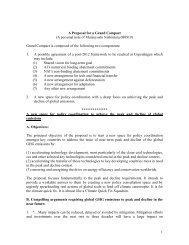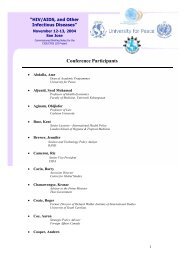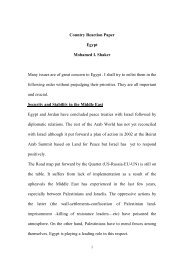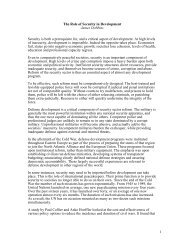WTO negotiations on agriculture: problems and ways ahead - L20.org
WTO negotiations on agriculture: problems and ways ahead - L20.org
WTO negotiations on agriculture: problems and ways ahead - L20.org
You also want an ePaper? Increase the reach of your titles
YUMPU automatically turns print PDFs into web optimized ePapers that Google loves.
From the perspective of developing countries, <strong>and</strong> – more importantly – theiragricultural producers, the classificati<strong>on</strong> of subsidies at the <str<strong>on</strong>g>WTO</str<strong>on</strong>g> is of less relevancethan their effects <strong>on</strong> markets. Export subsidies represent a major source of c<strong>on</strong>cern,since they are widely regarded as being am<strong>on</strong>g the most damaging. With the shift instructure of Northern support, the distincti<strong>on</strong> between export subsidies <strong>and</strong> domesticsupport is becoming increasingly artificial.This problem can be dem<strong>on</strong>strated by reference to Figure 1, which shows that, for thepurposes of <str<strong>on</strong>g>WTO</str<strong>on</strong>g> classificati<strong>on</strong>, the US was a n<strong>on</strong>-subsidising exporter at the end ofthe 1990s – <strong>and</strong> this remains the case. The EU accounted for over 90 per cent ofOECD export subsidies in 1999. However, even then they represented a relativelysmall comp<strong>on</strong>ent of overall support; <strong>and</strong> that comp<strong>on</strong>ent has been shrinking since1999. Cuts in guaranteed domestic prices allied to increases in world prices haveenabled the EU to export at prices above domestic levels. Only two major sectors –sugar <strong>and</strong> dairy – now c<strong>on</strong>sistently depend <strong>on</strong> direct export subsidies.The word 'direct' is operative in this c<strong>on</strong>text. Both the US <strong>and</strong> the EU provide veryhigh levels of support to sectors that are in structural surplus. Indeed, in many sectors,these surpluses would not exist in the absence of direct payments to farmers. Itfollows that direct payments include a de facto export subsidy, even though they arenot reported as such de jure for <str<strong>on</strong>g>WTO</str<strong>on</strong>g> purposes.The problem can best be dem<strong>on</strong>strated by reference to specific commodities. Menti<strong>on</strong>has already been made of the $4bn in direct payments allocated to cott<strong>on</strong> producers. Interms of <str<strong>on</strong>g>WTO</str<strong>on</strong>g> reporting, <strong>on</strong>ly around two per cent of these payments can becategorised as export subsidies. Yet in the absence of direct payments, US exportactivity in cott<strong>on</strong> would be much diminished for an obvious reas<strong>on</strong>: in most yearsaverage producti<strong>on</strong> costs c<strong>on</strong>siderably exceed world prices. Under n<strong>on</strong>-subsidisedc<strong>on</strong>diti<strong>on</strong>s, cott<strong>on</strong> would not be a profitable crop for the vast majority of USproducers. Cott<strong>on</strong> is not unique. In the case of rice, the OECD estimates US supportto be equivalent to just under half of the value of output. Around <strong>on</strong>e third ofproducti<strong>on</strong> is exported, again without the help of export subsidies. Similar c<strong>on</strong>diti<strong>on</strong>sprevail in maize <strong>and</strong> wheat. The point in all of these cases is that direct paymentsclearly spill over into export subsidies, though they are treated purely as domesticsupports for <str<strong>on</strong>g>WTO</str<strong>on</strong>g> purposes.In the interests of balance, it has to be acknowledged that the hidden export subsidiesat work in the EU are <strong>on</strong> a larger scale than those applied in the US. One way ofcapturing this scale is to adopt the simple expedient of dividing the volume of outputin any sector by the value of direct payments. This creates a unit value of subsidymeasure, which can in turn by c<strong>on</strong>verted into an export subsidy by reference to exportvolume. On this measure, the EU provides an export subsidy of around $610m for2001. However, no official export subsidies were recorded in this year, underliningthe limited nature of the current reporting regime.The sugar sector in the EU provides an even more telling example. Europe is theworld's sec<strong>on</strong>d largest exporter of sugar after Brazil, supplying around five milli<strong>on</strong>t<strong>on</strong>nes annually to the world market. These exports are sustained <strong>on</strong> an annual basis,even though guaranteed prices under the CAP are some four times world market13







